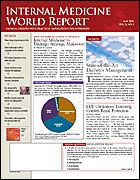Publication
Article
Mumps: Be Prepared to Treat a "Forgotten" Virus
Author(s):
ATLANTA—The United States is in the midst of the largest outbreak of mumps in more than 20 years, with thousands of cases having been reported from 8 states, mainly in the Midwest, according to Julie L. Gerberding, MD, MPH, director of the Centers for Disease Control and Prevention (CDC), who spoke at a press briefing on April 19, 2006.
Noting that several cases are under investigation in 7 additional states, Dr Gerberding said that the CDC will “not be surprised if there are more cases in more states, just given the nature of mumps and the way this outbreak is progressing.” The majority of cases have occurred in Iowa (Figure), where outbreaks have been reported at the state’s 3 largest universities.
A Crash Course
Many physicians may not be familiar with mumps, because there has been a vaccine since 1967 that has been largely successful in eliminating the virus in this country, Dr Gerberding noted.
“Mumps is a viral disease. It generally affects the body with fever, headache, and tiredness—the kinds of viruslike illness that we get with most of the common viruses. But it has a very special tendency to cause inflammation in your saliva glands, so people get the big, puffed cheeks from the involvement of those glands,” she explained.
Many clinicians, especially young physicians, have never seen a case of the mumps and need to be reminded about what the infection looks like. Keep in mind that some patients are not very symptomatic, and not everyone gets swollen glands, so mumps can easily be confused with other viral illnesses, she advised.
"We are encouraging clinicians who have any suspicion about cases to check with their local health officials to make sure they are doing everything they need to do to ascertain whether a case exists or not." ?Julie L. Gerberding, MD, MPH
“We are en­couraging clinicians who have any suspicion about cases to check with their local health officials to make sure they are doing everything they need to do to ascertain whether a case exists or not,” Dr Gerberding said.
The only good thing is that mumps is normally not a serious disease, she notes; however, it is associated with serious complications. About 10% of patients will develop meningitis, and some will develop orchitis, which can lead to infertility. Mumps has also reportedly been associated with spontaneous abortion and deafness.
“So although these complications are very rare, occasionally they are serious, and our understanding is that right now there have been at least 20 hospitalizations associated with this outbreak, but fortunately, so far, no deaths,” she said.
Clinical manifestations
The classic symptoms of infection with mumps involve a nonspecific prodrome that can include myalgia, anorexia, malaise, headache, and fever. This is followed by an acute onset of unilateral or bilateral tender, swollen parotid or other salivatory glands. Approximately 40% to 50% of cases are associated with nonspecific or primary respiratory symptoms, particularly in children aged <5 years, according to the CDC. About 30% to 40% of patients have typical acute parotitis, whereas 15% to 20% are asymptomatic.
Incubation period
According to the CDC, the incubation period for mumps averages between 16 to 18 days, with a range of anywhere from 12 to 25 days. Fever may continue for 3 to 4 days, and parotitis usually lasts 7 to 10 days. Patients diagnosed with mumps are considered to be infectious from 3 days before until 9 days after the onset of parotitis.
CDC Urges Vaccination
“I have to emphasize that the best protection against mumps is the vaccine,” said Dr Gerberding. Although not perfect, the mumps vaccine is quite effective if 2 full doses are given. Even so, roughly 10% of persons who receive both doses remain susceptible to infection. According to the CDC, although various strains of the vaccine are available, the most popular is the Jeryl Lynn strain, a live, attenuated strain of the mumps virus. It can be administered in its nonvalent form or as part of the mumps, measles, and rubella formulation.
The CDC is urging college-aged adults and health care workers to get vaccinated and make sure they have 2 doses. “There is a lot of confusion right now about whether or not this outbreak is related to some problem with the vaccine,” she said. “I want to emphasize that while we are investigating this outbreak, and we will learn more about the efficacy of the vaccine in this particular setting, we have absolutely no information to suggest that there is any problem with the vaccine.”
The most important step being taken in the affected areas is the implementation of vaccine programs for people who have not received both doses, she noted.
Dr Gerberding sent out a special call to health care workers, admonishing them that “if you have not received 2 doses of the mumps vaccine, it is very important you get your second dose.”
KEY POINTS
Symptoms include myalgia, anorexia, malaise, headache, and fever, followed by an acute onset of unilateral/bilateral tender, swollen salivatory glands.
About 15% to 20% of mumps cases are asymptomatic.
Incubation period averages 16–18 days. Patients are infectious for 3 days before and up to 9 days after parotitis onset.
Fever can last 3–4 days.
Parotitis usually lasts 7–10 days.






